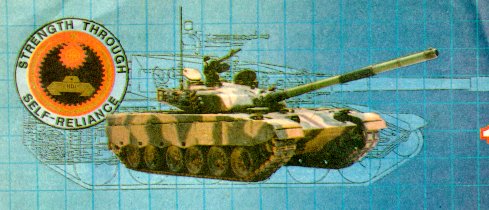
The Pakistan Army is commanded by the Chief of the Army Staff COAS who sits in the General Headquarters, Rawalpindi. He is assisted by PRINCIPAL STAFF OFFICERS who are two or three star generals. These are:-
Chief of General Staff (CGS), Adjutant General (AG), Quartermaster General (QMG), Master General of Ordinance (MGO), Inspector General Trining & evaluation (IG T&E), Military Secretary (MS).
The 20 Infantry & 2 Armoured Divisions are grouped under 9 different Corps headquarters commanded by 3-star Lieutenant Generals. These are:
I Corps (Mangla) II Corps (Multan) IV Corps (Lahore) V Corps (Karachi) X Corps (Rawalpindi) XI Corps (Peshawar) XII Corps (Quetta) XXX Corps (Gujranwala) XXXI Corps (Bahawalpur)
Personnel: 500,000
Main Battle tanks: 2000
Artillary pieces: 1700
Structure:
Infantry Divisions: 20
Armoured Divisions: 2
Mech. Infantry Div: 1
Artillery Division: 1
Independent Armoured
Brigades: 6
Independent Infantry
Brigades: 6
Air Defence Brigades: 4
Special Services group: 4
EQUIPMENT:
----------
MAIN BATTTLE TANKS
Mostly CHINESE: T-55/59/60/80s
T-60/80 being produced at HMC taxilla
about 400 AMERICAN M-47/48s
Work continues on MBT-2000 Al-Khalid
 |
 |
The change in Afghanistan also helped in putting a large amount of reserves at the disposal of the Pakistan Army, a factor which has been significant in neutralising the otherwise Indian numerical superiority in ground forces. Pakistan, for instance, has 10 Divisions in reserves, including 8 infantry and 2 armoured divisions. These largee reserves ensure that Pakistan today is better equiped to fight both offensive and defensive battles. Conversely, India has 18 divisions deployed on the borders with Pakistan, China and Bangladesh, while 16 are in reserve, out of which approximately 10 are deployed in counter insurgency operations in Kashmir, Punjab and Assam.
The second element which has been important for the Pakistan Army in recent years is the new doctrine of "offensive-defence" which was tested during the Pakistan Army's biggest-ever manoeuvres during late 1989, code-named "Exercise Zarb-e-Momin". Under this strategic concept, the Pakistan Army is viewed as a force capable of undertaking a strategic offensive on land, including the possiblity of taking the war into enemy territory, rather than waiting to be hit ass was the case in 1965 and 1971 wars.
The Pakistan Army today is in better shape than before is evident from the fact that it has 45 days of reserve ammunition and fuels in stocks as compared to 1965 when it only had 13 days of of stocks.
Another element which I has added to the Army's professional capability is the extreme stress on professional education, training and career planning. Priemier institutes like the Command and Staff College, Quetta, and the National Defence College are world renowned for their elaborate and contemporary curricula. About 200 officers from the Army are sent annually to foreign countries for training with 75% going to USA. Today, the PA has more than 50 Ph.Ds.
 to Home Pag |
 to Defence. |